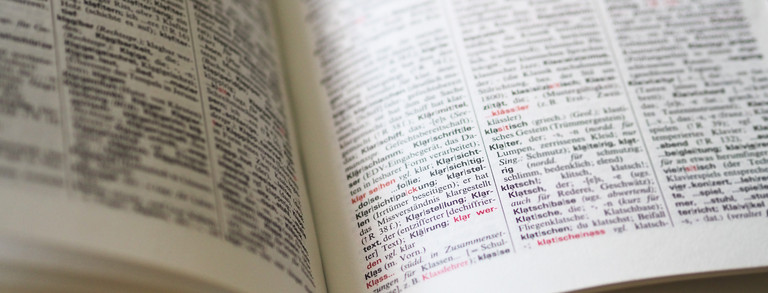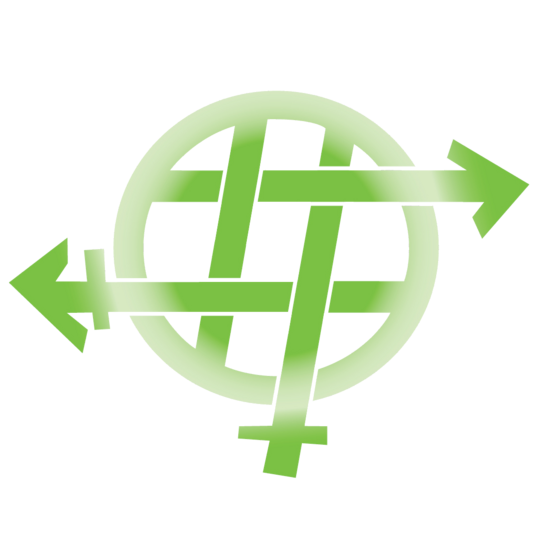#klargestellt
The constantly growing queerfeminist glossary offers an understanding aid for terms on gender and sexuality.
"I've never heard that before!" or "What was that exactly again?" - if you know this reaction from yourself or others in relation to terms from the topic spectrum of gender and sexuality, we have an offer for you. The queerfeminist glossary presents, without claiming to be exhaustive, a selection of terms that mostly refer to people's gender and sexuality. It is intended to encourage people to question their own use of language in everyday life as well as in the university context, to expand knowledge and to show ways in which language can be used in a way that is critical of discrimination.
#klargestellt is part of our project "Gender-Sensitive Language", because for successful equality it is important to clarify some terms. Klargestellt is a German term with multiple meanings. It can be translated as "to make clear" but also as "to set right". Gender equality means the implementation of equal rights for all genders, i.e. the elimination of existing structural discrimination based on gender. Gender justice also raises the question of which or whose gender or sexual orientation is made linguistically (in)visible and (in)conceivable. In the words of queer feminist author Laurie Penny: "We can only become what we can imagine and we can only imagine what we can articulate" (Laurie Penny: Bitch Doctrine, 2017). To realise gender justice, we need words that can respectfully articulate and make visible gender and sexual orientation.
The terms in this glossary are loaded with multi-layered, changeable meanings. Some refer to socially marginalised groups. Wherever possible, we would like to draw on critical discourses and self-definitions of marginalised communities that reject hurtful and standardising foreign terms, appropriate terms and reinterpret them in a self-empowering way. Nevertheless, the definitions are always only an approximation of individual definitions of individuals. The terms are based on the self-designations and discourses from German-speaking countries.
The glossary is meant to evolve through mutual exchange with readers.
We regularly put the definition of a term up for discussion under #clarified. Do you have questions or suggestions? Join the discussion and contribute to a better understanding of the terms! We welcome your feedback to: shk.gleichstellung@verwaltung.tu-dortmund.de
Glossary
Binary is derived from the Latin bini for "in pairs" or "two by two". Binary is based on the assumption of two mutually exclusive opposites, necessarily related to each other. Good and evil, body and mind, homosexual and heterosexual are examples of Western, binary concepts.
Bisexuality is derived from the Latin prefix bi- for two and describes the sexual orientation in which a person is romantically and/or sexually attracted to two or more genders and/or sexes. The term bi+sexuality is also used to extend the prefix bi-.
butch, the | butch (adj.) Butch is a (self-)description of mostly lesbian persons with rather masculine gender presentation and/or rather masculine gender consciousness.
Cis or cisgender is a term for people whose gender identity is consistent with the sex ascribed to them at birth based on their genitalia. Cis persons identify with the gender ascribed to them based on their innate physical characteristics. That is, for example: Cis men are men who were assigned male at birth and identify with it.
The term is derived from the Latin diversus and means "different, various".
Drag is a highly diverse, ambivalent, cultural form that can only be outlined here. Drag can be both an expression of personal identity and an artistic performance. For some, drag is inherently political; for others, it is a visual, performative art form.
Enby is a noun describing non-binary persons. It comes from the English abbreviation NB for non-binary, which is pronounced "enby." Enby is similar to the nouns man/woman/boy/girl, which it replaces. Recently the term is also used in the German-speaking world to make non-binary people visible as subjects in language.
Endo-gendered or dyadic refers to people who can be assigned explicitly to the medical-social norm of female and male at birth. Endo gender thus describes the counterpart of intersex.
Femme is a (self-)description used by mostly lesbian or queer people who express their gender identity in a more feminine way.
Gender is an important category of analysis in the social science and cultural studies and a central starting point in gender equality policy. It describes gender identity or rather social gender roles.
Heterosexuality is considered normal and natural. However, the concept of heterosexuality, as it is understood today, has not existed for very long.
Homosexuality describes a sexual orientation in which individuals are romantically, emotionally, and/or sexually attracted primarily or exclusively to their own sex (Homosexuality, 2017). The term "homosexual" has historically been used in a pathologizing and criminalizing manner and is not used by people to describe themselves. The more common labels of self for homosexual people are gay and lesbian.
In Germany, inter* is a collective term for people with innate characteristics that do not fit into the binary societal norm of female or male. The asterisk behind the word "inter" represents the diversity of inter* bodies and identities (Geschlecht und Geschlechtsidentität o.D.).
In German, this abbreviation stands for the self-designation ⇒Lesbisch, ⇒Schwul, ⇒Bisexuell, ⇒Transsexuell, ⇒Transgender, ⇒Intergeschlechtlich, ⇒Asexuell and ⇒Queer. In English, it stands for Lesbian, Gay, Bisexual, Transsexual, Transgender, Intersex, Asexual, and Queer/Questioning. The shorter form LSBT, or in English LGBT, is also frequently used. The abbreviation can also be used as an adjective chain if the individual letters are lowercase, e.g., as in "lsbttiaq persons."
Monosexuality describes a sexual orientation in which individuals are emotionally, romantically, and/or sexually exclusively attracted to one gender (Ritter, 2020). Monosexualities include heterosexuality and homosexuality.
In German, the ⇒ binary gender system is also linguistically reflected in the use of binary pronouns. "Sie"/"ihr" or "er"/"sein" are the common pronouns that are supposed to represent the gender of the person they stand for.
The term non-binary describes a wide range of different ways of experiencing one's gender: Many non-binary individuals locate their gender identity between male and female, meaning they are neither fully female nor fully male, or neither always female nor always male.
The term "pan" derives from Greek, meaning "everything". Pansexuality is a sexual orientation where a person can experience romantic and/or sexual attraction towards individuals, irrespective of their sex or gender . In other words, pansexual individuals can feel attracted to all gender identities. It is one of the polysexual orientations.
Polyamory is made up of the ancient Greek word poly for "several" and the Latin word amor for "love" and describes a certain way of loving and forming relationships (Polyamorie, 2023).
Polysexuality is rarely used to describe sexual orientation and is therefore rather unknown compared to bisexuality, heterosexuality, lesbian, or gay. Polysexuality is a sexual orientation in which a person feels romantically, emotionally, or sexually attracted to several, but not necessarily all, genders or gender identities (Polysexualität, 2017). Polysexuality can therefore be described as the opposite term to monosexuality.
Queer feminism refers to a multifaceted movement of feminism, both activist and academic, that has gained increasing prominence in Germany since the 1990s.
A person’s sex can be determined on the basis of various dimensions such as genes, chromosomes, hormones, gonads, internal sex organs and external sexual characteristics.
The asterisk is a placeholder for all terms that can be attached to the prefix "trans": transsexual, transgender, transident etc. (LAG Lesbians 2019 : 52).
Transgender is a self-description of persons who do not have the gender which was assigned to them at birth based on their genitalia. This may include identifying only partially with their assigned gender. Transgender individuals may be male or female but may also challenge the two-gender model. For example, many non-binary, genderfluid, or even genderqueer individuals and those located entirely outside the category of gender also count themselves as transgender, but not all. The word component "trans" comes from Latin and means "across" or "beyond"; gender refers to social roles based on the sex of a person
Transsexual is a self-designation and, in medico-legal discourses, a pathologizing external description for persons whose sex differs from the sex assigned at birth based on their genitalia. Transsexual persons are usually binary male or female, but nonbinary genders are also possible. The word component "sexual" or "sexuality" has nothing to do with sexual orientation but refers to sex, i.e., physical gender.






